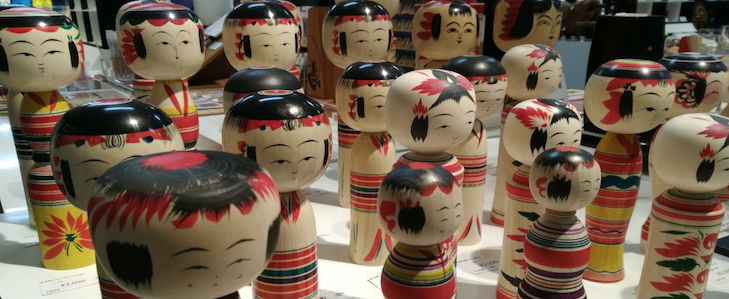
A day at Japan Traditional Crafts Aoyama Square: Meeting the Makie artist Hariya Takayuki
Thousands of tourists squeeze each other every day through the cramped streets in front of Sensoji in Asakusa in order to find souvenirs for themselves and their beloved ones at home. Most often they are looking for traditional Japanese crafts such as ceramics, lacquerware or Kokeshi dolls – something typical that represents Japan. They go from shop to shop, calculating and converting prices to save a few hundred yen until they are satisfied to have found the cheapest souvenir among all the stalls. And yet, it still has to be an authentic Japanese product. This does not just make me sad but probably lots of traditional craft enthusiasts as well.
The supposedly authentic craft souvenirs bought for a few hundred yen could not be further from the “real deal”.
Traditional crafts are deeply entwined with Japanese culture; the techniques often date back hundreds of years and each piece is carefully produced by an artisan who went through years of training and practice. Many tourists come to Japan to experience a country rich in culture. You turn a street and you find yourself standing in front of an old shrine. You wander through a Japanese garden and marvel at carefully designed landscapes. You join a traditional tea ceremony and drink matcha out of a beautifully handcrafted ceramic cup. If we are looking for the “real deal”, why don’t we get the “real deal”?
As so often, quantity seems to beat quality. But I hope to present an alternative to you – the wonderful world of traditional Japanese crafts.
The Association for the Promotion of Traditional Craft Industries was founded in 1975 to promote the industry for local Japanese crafts with Aoyama Square serving as its main flagship store located only a few minutes from Aoyama Itchome Station. Aoyama Square is not just an exhibition center but it also gives artisans a chance to sell their carefully crafted products, to get into contact with the customer and to show off their skills in workshops. Over 130 varieties of crafts from all over the country are brought together in this building, giving the visitor also the possibility to simply get an overview and inform him/herself about traditional crafts.
But what are traditional crafts exactly? According to the the Ministry of Economy, Trade and Industry, a craft has to fulfill the following criteria: the article must be used mainly in everyday life, it must be primarily manufactured by hand using traditional techniques and materials that have been used for at least 100 years and the production should be carried out by a certain number of regional enterprises.
Although pricey, Japanese crafts are everyday objects and should be used as such. Artisans invest a lot of their time and effort making objects that are supposed to hold for a long time, ranging from knives to lacquerware. Naturally, a product will eventually show signs of usage and age, but in this case a good knife can be sharpened and scratches in lacquerware can be repaired.
Aoyama Square holds permanent exhibitions with all-time popular products such as origami paper and postcards made from washi paper as well as special exhibitions with particular themes. From time to time there are workshops where you get to make crafts yourself and learn from the artisans. You are looking for something very specific? Knowledgeable staff can assist you in your search, answer any question or point you in the right decision. Even if you don’t fancy buying but are simply looking for a place to delve deeper into the world of traditional crafts, you will get excellent support. The association has published several info brochures also in English about the officially recognized crafts, where to find them and where to join workshops. You can check this website for the latest information. http://kougeihin.jp/facility_top/
http://kougeihin.jp/facility_top/
Meeting Makie artist Takayuki Hariya
When I first visited Aoyama Square, I came for a specific reason. I got the chance to not just talk with the people behind Aoyama Square but also to meet and interview a Makie artist.
Before meeting Mr. Takayuki Hariya I tried to prepare myself and find out a little bit about him and his passion. I am not exactly sure what I was looking for but I was surprised to see the photo of such a young man who seems to be rather active on Twitter in his free time (https://twitter.com/hariyat). His homepage (http://urushiarthariya.com/) was also easy to find and prepared me for what I would be dealing with; again, not what I was expecting. I thought I would meet a traditional Makie painter who sits all day in his little room and paints Makie on lacquerware. Instead, I got the chance to meet a painter who produces extremely beautiful and delicate and often modern geometrical designs on accessories addressed towards young and stylish people. There you go, my silly presumptions. I immediately fell in love with his art work and started thinking whether one of his necklaces wouldn’t make a perfect birthday present – for me.
Hariya Takayuki was born in 1983 in Yamanaka Onsen, Ishikawa Prefecture. The prefecture might not be on the must-visit list of many tourists except for its capital Kanazawa but Ishikawa is in fact known throughout Japan for its many crafts and arts such as Kanazawa lacquerware and Kutani ware.
Hariya’s parents are established Makie painters, so you would normally say he was born into this profession. However, Hariya admits that during his childhood he wasn’t interested at all in Makie. When he graduated high school and it was time to decide which path to go, he decided to enroll in Takaokatani University and study the subject of industrial design and lacquerware. Not because he was particularly interested but just to try it and enjoy his student days. Of course, things took a different turn or he wouldn’t be a Makie painter today. He studied the whole process of Makie from scratch, from making tools needed for painting to producing the final product. And instead of enjoying his student days the way he planned to, he found himself more and more immersed in the art of Makie, staying awake whole nights to paint in his little student room. I asked him what the most difficult part about Makie is and he answered, Makie actually isn’t so difficult because there is no fear of ruining your artwork in the process. You can simply remove the mistake and just paint it again. I still doubt it’s that easy.
You can be the best painter but it is still hard when you don’t understand what your potential customers want. After graduating university, Hariya first focused on painting on tea ceremony equipment but as it happens unfortunately with many traditional arts, not many Japanese people are willing anymore to learn and invest in it. He found himself a new niche, namely accessories, and thus managed to bring his passion for Makie into harmony with his young customers’ craving for unique and stylish designs.
Together with his family he created three main brands; Hariya, Bisai and Mt. Artigiano. While still offering more traditional imagery such as flowers and dragonflies, you will also find geometrical patterns, skulls and art nouveau inspired necklaces, brooches, watches, cufflinks and buttons for both women and men.
It takes around one month for a piece to be completed. The painting part itself doesn’t take so long but waiting for it to dry consumes the most time. He will paint just one delicate line on a little brooch, wait for it to dry for a whole day and then continue with another line on the third day. That’s why he usually paints around ten pieces with the same design in one go. Upon asked which designs are the most popular among his customers, he answers that Japanese women are especially fond of the cute animal designs such as owls and cats, which does not come as a real surprise in Japan.
Many traditional crafts in Japan are struggling but Hariya is relatively optimistic about the future of Makie. According to him, the art of Makie has a lot of possibilities to flourish even further because it is not limited to a certain medium or a certain style. Hariya learned this by focusing on jewellery and incorporating different styles. He collaborates with other artists and started introducing his work to a wider international audience. Hariya even joined a collaboration with other artists to craft a Katana designed by the internationally renowned artist Marc Newson. His modern approach to Makie proved to be fruitful; every year or so Hariya travels to Germany and France to exhibit his products. His latest project Button Down Pierce introduces collar buttons for smart shirts – a way for men to accessorize formal business attire in a very subtle way and which proved to be very popular among men in France.
I was deeply impressed by Hariya’s work. Not just because of his beautiful jewellery. But also because he showed that crafts are not just about tradition but also about innovation, reinvention and adaptation. Hariya managed this balancing act of incorporating tradition and craft while adjusting to the modern individual. I wish him all the best for the future.
Yes, traditional crafts can be expensive. But there is a reason for them to be pricey. Crafts represent and incorporate Japanese culture and tradition. They are everyday objects made to last for a long time by artisans that underwent years and years of training. They are the “real deal”.
Japan Traditional Crafts Aoyama Square
Opening Times: Mon to Sun, 11:00 – 19:00 (except Year-End & New Year Holidays)
Address: 8-1-22 Akasaka Minato-ku 107-0052, Tokyo Prefecture
Tel: +81 3-5785-1301
Website: http://kougeihin.jp/
Hariya Takayuki
Website: http://urushiarthariya.com/



